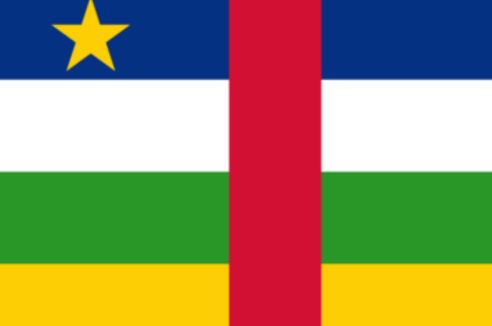Central African Republic
Central African Republic


The Central African Republic, located in the continent’s very center, has an eventful history marked by the rise and fall of ancient kingdoms, the atrocities of the transatlantic slave trade, and the dominance of colonial powers. The people and events of Central African Republic’s history are what make it so fascinating, and this article will shed light on both.
Historic Empires and Commerce Routes
Ancient African kingdoms like the Ouaddai, Kanem-Bornu, and Baguirmi previously flourished in what is now the Central African Republic. These dynasties flourished because they participated in trade between the Sahara and the Atlantic. Because of its central location, the area was an important hub for the flow of goods and ideas between different areas of Africa.
Slavery and colonial rule: a blight on humanity
The Central African Republic, like many other parts of Africa, was severely impacted by the transatlantic slave trade. Communities were wiped out and entire regions were depopulated as a result of slave raids. After that, European powers divided over Africa, and at the end of the nineteenth century, this region, then called Ubangi-Shari, was a French colony. The French colonizers used forced labor and squandered the country’s natural riches.
Free Will and Peril
On August 13, 1960, the Central African Republic became free of French rule thanks to the efforts of Barthélemy Boganda. However, the nascent nation experienced many obstacles, including as political instability, military coups, and economic problems. The authoritarianism and human rights violations committed by the Jean-Bédel Bokassa administration, which ruled the country from 1966 to 1979, tarnished the early years of independence.
The Central African Republic has a history marked by struggle and perseverance. The nation has weathered ancient monarchies, the atrocities of slavery, and the trials of freedom, all while striving for stability and advancement. The Central African Republic’s modern identity and goals can only be understood in light of its turbulent past.
Located in the middle of the African continent, the Central African Republic (CAR) has a rich history defined by shifting social and political forces. The region had the scars of slavery, an institution that changed cultures everywhere. This article will examine the evolution of anti-slavery activism in the Central African Republic, from its earliest beginnings to the present day.
The Central African Republic’s Slave Origins
The Central African Republic had a history of slavery that predates European invasion. Its roots may be traced back to wars between different tribes, making it an integral part of the region’s culture and society. People who were captured from other tribes typically became slaves. Slaves served as servants, concubines, and in the armed forces.
Africa to the Americas Slave Trade
Slavery in the Central African Republic took on new dimensions with the development of the trans-Saharan and transatlantic slave trades. Slave traffickers from the Middle East and Europe built trade routes, taking advantage of preexisting customs and wars to obtain captives. Slaves from the area suffered unfathomable abuse when they were shipped to places including North Africa, the Middle East, and the Americas.
The French colonial empire had a stronghold in the area. Colonial authorities either turned a blind eye to or actively participated in the slave trade, ensuring that slavery flourished. As a result, the local community suffered even more at the hands of slave owners who subjected their slaves to forced labor, sexual exploitation, and other sorts of torture.
Slavery has a profound impact on Central African Republic’s culture and history. It was a cruel system that kept people apart and resulted in unimaginable agony.
Mbïti, ngö, koro, mòyò, gara, bï, ti, ï, na, tï, bë, tië, kï, ngï, bïï, ïï, bo, to, ko, go, mbo, kïï, ba, ma, kïtï, gï, le, te, pe, re, se, fe, ne, mï, mboï, ngïï, kïtïï, kïtïïtï, kïtïïtïï, kïtïïtïtï, kïtïïtïtïtï, yï, ye, lo, so, fo, no, do, ho, wo, toï, ïïï, loï, ïn, ïïn, pï, mïï, tïï, lï, hï, wï, nï, dï, fï, bïïn, ïïïï, lïï, kïïï, ngïïï, sï, sïï, dïï, nïï, tïïï, hïï, gïï, fïï, mïïï, pïï, sïïï, wïï, yïï, bïïï, ïïïïï, ïïïïïï, ïïïïïïï, yïï, nyï, nyïï, nyïïï, nyïïïï, nyïïïïï, yïïïï, ïïïïn, ïïïïnï, ïïïïïnï, ïïïïïnïï, ïïïïïnïïï, ïïïïïnïïïï, ïïïïïïn, ïïïïïïnï, ïïïïïïnïï, ïïïïïïnïïï, ïïïïïïnïïïï, wïïïï, wïïïï, ïïïnïï, ïïïnïïï, ïïïïnïïïï, nïïïï, nïïïïï, sïïïï, sïïïïï, hïïïï, hïïïïï, mïïïï, mïïïïï, fïïïï, fïïïïï, tïïïï, tïïïïï, bïïïï, bïïïïï, gïïïï, gïïïïï, kïïïï, kïïïïï, pïïïï, pïïïïï, ïïïïïï, ïïïïïïï, yïïïïïï, ïïïïïïïï, lïïïïï, lïïïïïï, dïïïïï, dïïïïïï, wïïïïï, wïïïïïï, tïïïïïï, tïïïïïïï, ïïïïïïïïï, ïïïïïïïïïï, ngïïïïï, ngïïïïïï, mïïïïïï, mïïïïïïï, pïïïïïï, pïïïïïïï, sïïïïïï, sïïïïïïï, nïïïïïï, nïïïïïïï, fïïïïïï, fïïïïïïï, bïïïïïï, bïïïïïïï, kïïïïïï, kïïïïïïï, yïïïïïï, yïïïïïïï, wïïïïïï, wïïïïïïï, tïïïïïïï, tïïïïïïïï, mïïïïïïï, mïïïïïïïï, gïïïïïï, gïïïïïïï, pïïïïïïï, pïïïïïïïï, hïïïïïï, hïïïïïïï, ngïïïïïï, ngïïïïïïï, sïïïïïïï, sïïïïïïïï, fïïïïïïï, fïïïïïïïï, tïïïïïïïï, tïïïïïïïïï, bïïïïïïïï, bïïïïïïïïï, kïïïïïïïï, kïïïïïïïïï, pïïïïïïïï, pïïïïïïïïï, ïïïïïïïïïï, ïïïïïïïïïïï, yïïïïïïïïïï, ïïïïïïïïïïïï, lïïïïïïïïï, lïïïïïïïïïï, dïïïïïïïïï, dïïïïïïïïïï, wïïïïïïïïï, wïïïïïïïïïï, tïïïïïïïïïï, tïïïïïïïïïïï, ïïïïïïïïïïïïï, ïïïïïïïïïïïïïï, ngïïïïïïïïï, ngïïïïïïïïïï, mïïïïïïïïïï, mïïïïïïïïïïï, pïïïïïïïïïï, pïïïïïïïïïïï, sïïïïïïïïïï, sïïïïïïïïïïï, nïïïïïïïïïï, nïïïïïïïïïïï, fïïïïïïïïïï, fïïïïïïïïïïï, bïïïïïïïïïï, bïïïïïïïïïïï, kïïïïïïïï













You must be logged in to post a comment Login